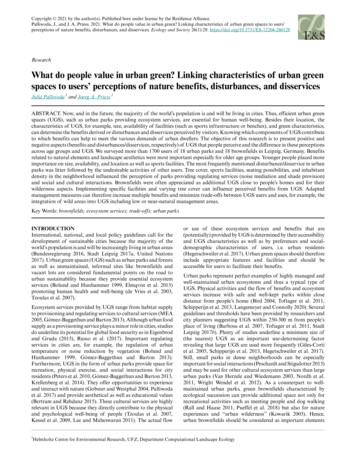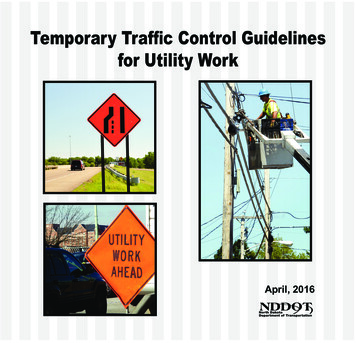
Transcription
edwithwithvegetablevegetableoil ead,eventheytheyseemseemhealthy.healthy.they seem rsandpapertemperatureMakesure ovating(call(call1-800-4241-800-424when remodeling or renovating (call atureheat often.often. surfaces that may contain tedtestedforforlead,lead,evenevenif etablevegetableoil rPrinted with vegetable oil based inks on recycled m 50% postconsumer) process chlorine urYourHomeHomeHomeLeadLead Safety ingandandUrbanUrbanDevelopmentDevelopmentand Urban Development
Are You Planning To Buy, Rent, or Renovatea Home Built Before 1978?Many houses and apartments built before 1978 havepaint that contains high levels of lead (called leadbased paint). Lead from paint, chips, and dust canpose serious health hazards if not taken care of properly.OWNERS, BUYERS, and RENTERS areencouraged to check for lead (see page 6)before renting, buying or renovating pre1978 housing.Federal law requires that individuals receive certaininformation before renting, buying, or renovatingpre-1978 housing:LANDLORDS have to disclose known information on lead-based paint and lead-basedpaint hazards before leases take effect.Leases must include a disclosure aboutlead-based paint.SELLERS have to disclose known information on lead-based paint and lead-basedpaint hazards before selling a house. Salescontracts must include a disclosure aboutlead-based paint. Buyers have up to 10days to check for lead.RENOVATORS disturbing more than 2 squarefeet of painted surfaces have to give youthis pamphlet before starting work.CPSC Regional OfficesYour Regional CPSC Office can provide further information regarding regulations and consumer product safety.Eastern Regional CenterConsumer Product Safety Commission201 Varick Street, Room 903New York, NY 10014(212) 620-4120Western Regional CenterConsumer Product Safety Commission1301 Clay Street, Suite 610-NOakland, CA 94612(510) 637-4050Central Regional CenterConsumer Product Safety Commission230 South Dearborn Street, Room 2944Chicago, IL 60604(312) 353-8260HUD Lead OfficePlease contact HUD's Office of Healthy Homes and Lead HazardControl for information on lead regulations, outreach efforts, andlead hazard control and research grant programs.U.S. Department of Housing and Urban DevelopmentOffice of Healthy Homes and Lead Hazard Control451 Seventh Street, SW, P-3206Washington, DC 20410(202) 755-1785This document is in the public domain. It may be reproduced by an individual ororganization without permission. Information provided in this booklet is basedupon current scientific and technical understanding of the issues presented andis reflective of the jurisdictional boundaries established by the statutes governingthe co-authoring agencies. Following the advice given will not necessarily provide complete protection in all situations or against all health hazards that canbe caused by lead exposure.U.S. EPA Washington DC 20460U.S. CPSC Washington DC 20207U.S. HUD Washington DC 20410EPA747-K-99-001June 200313
IMPORTANT!EPA Regional OfficesYour Regional EPA Office can provide further information regarding regulations and lead protection programs.EPA Regional OfficesRegion 1 (Connecticut, Massachusetts,Maine, New Hampshire, Rhode Island,Vermont)Regional Lead ContactU.S. EPA Region 1Suite 1100 (CPT)One Congress StreetBoston, MA 02114-20231 (888) 372-7341Region 2 (New Jersey, New York,Puerto Rico, Virgin Islands)Regional Lead ContactU.S. EPA Region 22890 Woodbridge AvenueBuilding 209, Mail Stop 225Edison, NJ 08837-3679(732) 321-6671Region 3 (Delaware, Maryland,Pennsylvania, Virginia, Washington DC,West Virginia)Regional Lead ContactU.S. EPA Region 3 (3WC33)1650 Arch StreetPhiladelphia, PA 19103(215) 814-5000Region 4 (Alabama, Florida, Georgia,Kentucky, Mississippi, North Carolina,South Carolina, Tennessee)Regional Lead ContactU.S. EPA Region 461 Forsyth Street, SWAtlanta, GA 30303(404) 562-8998Region 5 (Illinois, Indiana, Michigan,Minnesota, Ohio, Wisconsin)Regional Lead ContactU.S. EPA Region 5 (DT-8J)77 West Jackson BoulevardChicago, IL 60604-3666(312) 886-600312Region 6 (Arkansas, Louisiana, NewMexico, Oklahoma, Texas)Regional Lead ContactU.S. EPA Region 61445 Ross Avenue, 12th FloorDallas, TX 75202-2733(214) 665-7577Region 7 (Iowa, Kansas, Missouri,Nebraska)Regional Lead ContactU.S. EPA Region 7(ARTD-RALI)901 N. 5th StreetKansas City, KS 66101(913) 551-7020Region 8 (Colorado, Montana, NorthDakota, South Dakota, Utah, Wyoming)Regional Lead ContactU.S. EPA Region 8999 18th Street, Suite 500Denver, CO 80202-2466(303) 312-6021Region 9 (Arizona, California, Hawaii,Nevada)Regional Lead ContactU.S. Region 975 Hawthorne StreetSan Francisco, CA 94105(415) 947-4164Region 10 (Alaska, Idaho, Oregon,Washington)Regional Lead ContactU.S. EPA Region 10Toxics Section WCM-1281200 Sixth AvenueSeattle, WA 98101-1128(206) 553-1985Lead From Paint, Dust, andSoil Can Be Dangerous If NotManaged ProperlyFACT: Lead exposure can harm youngchildren and babies even before theyare born.FACT: Even children who seem healthy canhave high levels of lead in their bodies.FACT: People can get lead in their bodies bybreathing or swallowing lead dust, or byeating soil or paint chips containinglead.FACT: People have many options for reducinglead hazards. In most cases, lead-basedpaint that is in good condition is not ahazard.FACT: Removing lead-based paint improperlycan increase the danger to your family.If you think your home might have leadhazards, read this pamphlet to learn somesimple steps to protect your family.1
Lead Gets in the Body in Many WaysChildhoodleadpoisoningremains amajorenvironmental healthproblem inthe U.S.People can get lead in their body if they:Breathe in lead dust (especially duringrenovations that disturb paintedsurfaces).Put their hands or other objectscovered with lead dust in their mouths.Eat paint chips or soil that containslead.Lead is even more dangerous to childrenunder the age of 6:At this age children’s brains and nervoussystems are more sensitive to the damaging effects of lead.Even childrenwho appearhealthy canhave dangerous levels oflead in theirbodies.Children’s growing bodies absorb morelead.Babies and young children often puttheir hands and other objects in theirmouths. These objects can have leaddust on them.Lead is also dangerous to women ofchildbearing age:Women with a high lead level in theirsystem prior to pregnancy would exposea fetus to lead through the placentaduring fetal development.For More InformationThe National Lead Information CenterCall 1-800-424-LEAD (424-5323) to learnhow to protect children from lead poisoningand for other information on lead hazards.To access lead information via the web, visitwww.epa.gov/lead andwww.hud.gov/offices/lead/.EPA’s Safe Drinking Water HotlineCall 1-800-426-4791 for information aboutlead in drinking water.Consumer Product SafetyCommission (CPSC) HotlineTo request information on lead inconsumer products, or to report anunsafe consumer product or a product-related injury call 1-800-6382772, or visit CPSC's Web site at:www.cpsc.gov.Health and Environmental AgenciesSome cities, states, and tribes havetheir own rules for lead-based paintactivities. Check with your local agency tosee which laws apply to you. Most agenciescan also provide information on finding alead abatement firm in your area, and onpossible sources of financial aid for reducinglead hazards. Receive up-to-date addressand phone information for your local contacts on the Internet at www.epa.gov/leador contact the National Lead InformationCenter at 1-800-424-LEAD.For the hearing impaired, call the Federal InformationRelay Service at 1-800-877-8339 to access any ofthe phone numbers in this brochure.211
Other Sources of LeadDrinking water. Your home might haveplumbing with lead or lead solder. Callyour local health department or watersupplier to find out about testing yourwater. You cannot see, smell, or tastelead, and boiling your water will not getrid of lead. If you think your plumbingmight have lead in it:While paint, dust,and soil are themost commonsources of lead,other leadsources also exist. Use only cold water for drinking andcooking. Run water for 15 to 30 secondsbefore drinking it, especially if youhave not used your water for a fewhours.The job. If you work with lead, youcould bring it home on your hands orclothes. Shower and change clothesbefore coming home. Launder your workclothes separately from the rest of yourfamily’s clothes.Lead’s EffectsIt is important to know that even exposureto low levels of lead can severely harmchildren.In children, lead can cause:Nervous system and kidney damage.Brain or Nerve DamageLearning disabilities, attention deficitdisorder, and decreased intelligence.HearingProblemsSpeech, language, and behaviorproblems.Poor muscle coordination.SlowedGrowthDecreased muscle and bone growth.Hearing damage.While low-lead exposure is mostcommon, exposure to high levels oflead can have devastating effects onchildren, including seizures, unconsciousness, and, in some cases, death.Although children are especiallysusceptible to lead exposure, leadcan be dangerous for adults too.Old painted toys and furniture.In adults, lead can cause:DigestiveProblemsFood and liquids stored in lead crystalor lead-glazed pottery or porcelain.Increased chance of illness duringpregnancy.ReproductiveProblems(Adults)Lead smelters or other industries thatrelease lead into the air.Harm to a fetus, including braindamage or death.Hobbies that use lead, such as makingpottery or stained glass, or refinishingfurniture.Fertility problems (in men and women).High blood pressure.Folk remedies that contain lead, such as“greta” and “azarcon” used to treat anupset stomach.Nerve disorders.Lead affectsthe body inmany ways.Digestive problems.Memory and concentration problems.Muscle and joint pain.103
Where Lead-Based Paint Is FoundIn general,the older yourhome, themore likely ithas leadbased paint.Many homes built before 1978 have leadbased paint. The federal governmentbanned lead-based paint from housing in1978. Some states stopped its use evenearlier. Lead can be found:In homes in the city, country, or suburbs.In apartments, single-family homes, andboth private and public housing.Inside and outside of the house.In soil around a home. (Soil can pick uplead from exterior paint or other sourcessuch as past use of leaded gas in cars.)Checking Your Family for LeadGet yourchildren andhome testedif you thinkyour homehas high levels of lead.To reduce your child's exposure to lead,get your child checked, have your hometested (especially if your home has paintin poor condition and was built before1978), and fix any hazards you may have.Children's blood lead levels tend to increaserapidly from 6 to 12 months of age, andtend to peak at 18 to 24 months of age.Consult your doctor for advice on testingyour children. A simple blood test candetect high levels of lead. Blood tests areusually recommended for:Children at ages 1 and 2.Children or other family members whohave been exposed to high levels of lead.Children who should be tested underyour state or local health screening plan.Your doctor can explain what the test resultsmean and if more testing will be needed.4Remodeling or Renovating a Home WithLead-Based PaintTake precautions before your contractor oryou begin remodeling or renovating anything that disturbs painted surfaces (suchas scraping off paint or tearing out walls):Have the area tested for lead-basedpaint.Do not use a belt-sander, propanetorch, high temperature heat gun, dryscraper, or dry sandpaper to removelead-based paint. These actions createlarge amounts of lead dust and fumes.Lead dust can remain in your homelong after the work is done.Temporarily move your family (especially children and pregnant women)out of the apartment or house untilthe work is done and the area is properly cleaned. If you can’t move yourfamily, at least completely seal off thework area.Follow other safety measures toreduce lead hazards. You can find outabout other safety measures by calling1-800-424-LEAD. Ask for the brochure“Reducing Lead Hazards WhenRemodeling Your Home.” This brochureexplains what to do before, during,and after renovations.If you have already completed renovations or remodeling that could havereleased lead-based paint or dust, getyour young children tested and followthe steps outlined on page 7 of thisbrochure.If notconductedproperly,certain typesof renovations canrelease leadfrom paintand dust intothe air.9
Reducing Lead Hazards In The HomeRemovingleadimproperlycan increasethe hazard toyour familyby spreadingeven morelead dustaround thehouse.Always use aprofessional whois trained toremove leadhazards safely.In addition to day-to-day cleaning and goodnutrition:You can temporarily reduce lead hazardsby taking actions such as repairing damaged painted surfaces and planting grassto cover soil with high lead levels. Theseactions (called “interim controls”) are notpermanent solutions and will need ongoing attention.To permanently remove lead hazards,you should hire a certified lead “abatement” contractor. Abatement (or permanent hazard elimination) methodsinclude removing, sealing, or enclosinglead-based paint with special materials.Just painting over the hazard with regularpaint is not permanent removal.Lead-based paint is usually not a hazard ifit is in good condition, and it is not on animpact or friction surface, like a window. Itis defined by the federal government aspaint with lead levels greater than or equalto 1.0 milligram per square centimeter, ormore than 0.5% by weight.Deteriorating lead-based paint (peeling,chipping, chalking, cracking or damaged)is a hazard and needs immediate attention.It may also be a hazard when found on surfaces that children can chew or that get alot of wear-and-tear, such as:Lead frompaint chips,which youcan see, andlead dust,which youcan’t alwayssee, can bothbe serioushazards.Windows and window sills.Doors and door frames.Stairs, railings, banisters, and porches.Always hire a person with special trainingfor correcting lead problems—someonewho knows how to do this work safely andhas the proper equipment to clean upthoroughly. Certified contractors will employqualified workers and follow strict safetyrules as set by their state or by the federalgovernment.Lead dust can form when lead-based paint is scraped, sanded, orheated. Dust also forms when painted surfaces bump or rub together. Lead chips and dust can get on surfaces and objects that peopletouch. Settled lead dust can re-enter the air when people vacuum,sweep, or walk through it. The following two federal standards havebeen set for lead hazards in dust:Once the work is completed, dust cleanupactivities must be repeated until testingindicates that lead dust levels are below thefollowing:250 µg/ft2 and higher for interior window sills.40 micrograms per square foot (µg/ft2)for floors, including carpeted floors;250 µg/ft2 for interior windows sills; and8Identifying Lead Hazards40 micrograms per square foot (µg/ft2) and higher for floors,including carpeted floors.Lead in soil can be a hazard when children play in bare soil orwhen people bring soil into the house on their shoes. The followingtwo federal standards have been set for lead hazards in residentialsoil:400 parts per million (ppm) and higher in play areas of bare soil.400 µg/ft2 for window troughs.1,200 ppm (average) and higher in bare soil in the remainder ofthe yard.Call your state or local agency (see bottomof page 11) for help in locating certifiedprofessionals in your area and to see iffinancial assistance is available.The only way to find out if paint, dust and soil lead hazards exist isto test for them. The next page describes the most common methods used.5
Checking Your Home for LeadJust knowingthat a homehas leadbased paintmay not tellyou if thereis a hazard.You can get your home tested for lead inseveral different ways:A paint inspection tells you whether yourhome has lead-based paint and where itis located. It won’t tell you whether or notyour home currently has lead hazards.A risk assessment tells you if your homecurrently has any lead hazards from leadin paint, dust, or soil. It also tells you whatactions to take to address any hazards.A combination risk assessment andinspection tells you if your home hasany lead hazards and if your home hasany lead-based paint, and where thelead-based paint is located.Hire a trained and certified testing professional who will use a range of reliablemethods when testing your home.Visual inspection of paint conditionand location.A portable x-ray fluorescence (XRF)machine.Lab tests of paint, dust, and soilsamples.There are state and federal programs inplace to ensure that testing is done safely,reliably, and effectively. Contact your stateor local agency (see bottom of page 11) formore information, or call 1-800-424-LEAD(5323) for a list of contacts in your area.Home test kits for lead are available, butmay not always be accurate. Consumersshould not rely on these kits before doingrenovations or to assure safety.6What You Can Do Now To ProtectYour FamilyIf you suspect that your house has leadhazards, you can take some immediatesteps to reduce your family’s risk:If you rent, notify your landlord ofpeeling or chipping paint.Clean up paint chips immediately.Clean floors, window frames, windowsills, and other surfaces weekly. Use amop or sponge with warm water and ageneral all-purpose cleaner or a cleanermade specifically for lead. REMEMBER:NEVER MIX AMMONIA AND BLEACHPRODUCTS TOGETHER SINCE THEYCAN FORM A DANGEROUS GAS.Thoroughly rinse sponges and mopheads after cleaning dirty or dustyareas.Wash children’s hands often, especially before they eat and before nap timeand bed time.Keep play areas clean. Wash bottles,pacifiers, toys, and stuffed animalsregularly.Keep children from chewing windowsills or other painted surfaces.Clean or remove shoes beforeentering your home to avoidtracking in lead from soil.Make sure children eatnutritious, low-fat meals highin iron and calcium, such asspinach and dairy products.Children with good diets absorbless lead.7
Take precautions to avoid exposure to lead dust when remodeling or renovating (call 1-800-424-LEAD for guidelines). Don't use a belt-sander, propane torch, high temperature heat gun, scraper, or sandpaper on painted surfaces that may contain lead. Don't try to remove lead-based paint yourself. Simple Steps To Protect Your Family











